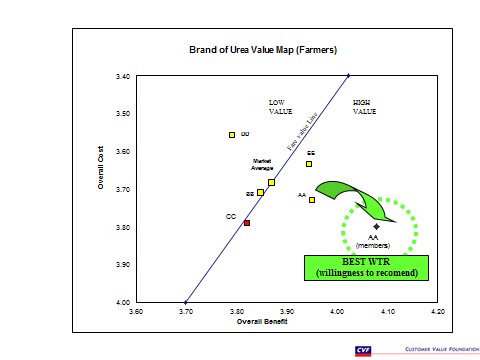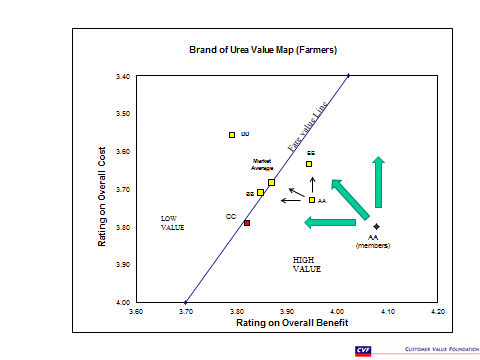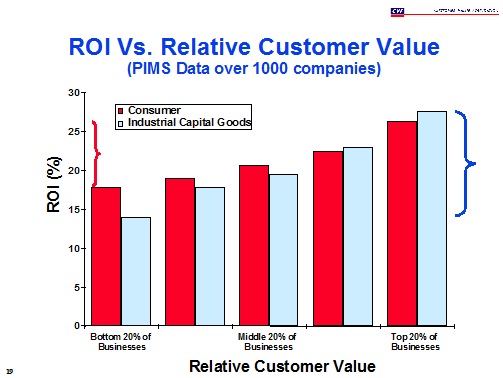There is has been much talk about giving away too much to the Customer to the detriment of the Company. Companies should be Customer-centric but not too Customer-centric. Critics of Customer Value Creation think of Customer Value people as naïve and running the risk of reducing Value to the Company.
Customer Value is actually used to get the best possible Value to the Customer. It also can tell what Value the Company gets and when Value is being destroyed for the Company and how to correct this.
Customer-centricity advocates are saying a blanket Customer-centric approach may back fire. How do we prevent this?
Let’s start with what is evident. Customers buy those products they perceive will give them more Value than competitive products. Customer Value is measured by a metric called Customer Value Added (CVA).
CVA is:
The Value (benefits-cost) added by your Company to its Customers
The Value Added by your competitor to its Customers
Obviously the name of the game is to add benefits or cut costs or price to increase Customer Value. The easiest thing to do is cut price which can increase Customer Value. But this can get you into a price war, and if carried too far can be deadly. Every time you lower the price by 1% the Company profit decreases 10-15%. So in creating Value to the Customer by price cutting you are destroying Value for the Company.
Or if you add benefits and do not get a price for it, then again Value is destroyed for the Company if the benefit improvement has caused a higher cost to the Company. Often, service benefits are for free (doing the right things, having a good attitude), and in this case creating the Value for the Customer does not destroy the Value for the Company. And if you could get a price improvement then the Value for the Company goes up.
When you conduct a Customer Value Added study, you also get to create a Value map. You want to see graphically whether you are adding or destroying Value to the Customer, and whether you are giving away Value (and just getting Customers to prefer you, and actually destroying Value for the Company).
I am going to show you the same Value map twice to make my point. This is real data through a market research with Customers. To understand the chart, the Y axis shows the rating on the cost. As the perception of cost (not the actual cost) goes up, the scores reduce. The lowest perception of cost is 3.4 (means the cost is high) and the highest on the chart is 4 on a 5 point scale (means the cost is low).
The first chart shows Company EE provides the same benefits as Company AA, but is perceived to be higher in cost, and therefore adds less value than Company AA. Company AA started a membership scheme. The chart shows what happens to Company AA’s Customers when they become members and more Value is added. The Value addition was to make some Customers of AA members of a club. That boosted the ego of the Customer, improved his sense of belonging and relationship with the brand.

The Value went up and the willingness to recommend was the highest for this group. But most interesting, the price was not reduced for the AA members versus the rest of the AA Customers. But the overall cost score had gone up (the members perceived a lower cost).
Making them members increased the Customer Value they perceived they received. In this particular case, not much cost was incurred by the Company in making members. They just let it be known they were making members, and members were given badges and recognised at the retail stores by the retailer.
Note: high Value creation for the Customer is to the right of the fair Value line, and AA, EE are adding Value to the Customer, and DD is destroying Value. BB and CC are fairly priced, and deliver average Value.
The second chart focuses on increasing the Value to the Company or the profit. Starting with AA members, we notice an immense Customer Value is being created for them (see the distance from the fair value line (the only line on the chart). We can increase the price (shown by the vertical green arrow going up), reduce the benefits (green arrow going to the left), or both (green arrow going diagonally towards the fair Value line). One could increase revenues by charging a membership fee.
A better way is to increase price for AA’s Customers (members and non-members) or reduce the benefits (such as sales credit, or free delivery).
All these will increase the revenue to the Company and its profit. It is better to ensure we continue to be in the high Value zone and add more Value than competitors. These strategies have worked to increase Value to the Company.

In addition CVA also relates to market share and profits. As CVA goes up and down market share follows. See chart below:

Further, as CVA goes up, ROI goes up, as we can see in the chart below.

This article proves to those who believe Customer Value proponents only think of creating Value to the Customer that they add Value to the company also. In addition they can do this study for various Customer segments and assess which segments are higher value adding to the Company.



